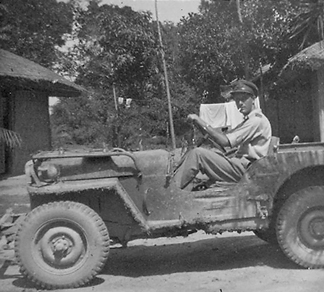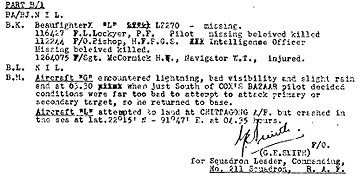 |
 |
|||
|
F/Lt Philip Francis Lockyer 116427 KAO 3 June 1945 Philip Francis Lockyer first joined the Army, perhaps in 1940 (or perhaps earlier, in the ranks). At some point, either on entry or in service, he was marked as Officer material and was duly posted to 168 Officer Cadet Training Unit at Aldershot. From there he passed out a 2nd Lieutenant (a Subaltern, most junior Officer rank in the Army). In late December 1940 Lockyer was posted to the Lancashire Fusiliers: the Infantry. At some point he decided on RAF service rather than the Army, a choice which many an Army man made or was offered during the war. So in April 1942 Philip Lockyer relinquished his Army commission, the same day taking up a commission as Pilot Officer in the RAFVR (the most usual route for entering the RAF in war-time).
Gazettal as Flying Officer came in April 1943, with effect from October 1942, perhaps reflecting his passing out from training as a Pilot. Further advanced training would follow, possibly at an Air Navigation School or the like, and finally at a Beaufighter-specific Operational Training Unit to focus on long range operations. By this time he'd likely have crewed up with his regular Navigator, Sgt Herbert William McCormick 1264075, most probably at their OTU. Only after this would their first operational posting come: apparently to 211 Squadron. To 211 Squadron Operating by day and by night in long-range strike sorties out over Burma, crews could expect to be "on the job" two or three times a week, sometimes in poor weather and against difficult targets. For the Beaufighter Squadrons in India at this time, an operational tour was 300 hours—a very big ask. In this early period, Lockyer first appears in the 211 Squadron Operations Record Book arriving on 6 October as Flying Officer pilot. In the manner of the time, as an NCO, McCormick’s arrival went unremarked. The distance between a Sgt Navigator and a P/O as his Pilot (by way of Service command, discipline, quarters, messing and so on) can be encapsulated in a single word: Sir. Despite the barrier of rank, good men did make good crews: not just by skill in the air but by finding ways between them to forge the vital trust, confidence, cohesion, and mateship needed to survive operations together. Those that did not were more liable to pay a heavy price in the air, under stress of combat, weather or mechanical difficulty. Those that did often expressed some surprise, post-war, about how lucky they were to have found such a good crewmate. And even good crews could still run out of luck in the air. Lockyer and McCormick’s first operation is recorded in the 211 Squadron Operations Record Book on 12 January 1944. The pair undertook a 3hr 40min Rhubarb sortie in Beaufighter Mk X LZ230 'A' out to the Irrawaddy and along the railway to Naba. In April 1944, Lockyer was promoted Flight Lieutenant. By 22 April the pair had completed at least 22 sorties (the Operations Record Book is rather difficult to follow for some of this period but certainly 22 and just possibly more). A very experienced crew, whatever their tally. By May, Lockyer was made ‘A’ Flight Commander. McCormick had already been made Flight Sergeant. Due for a commission, in the way of the Service it was October before he was formally gazetted Pilot Officer, with effect from April. Monsoon ops On the night of 2/3 June, Lockyer and McCormick were about to make their 25th operational sortie. They took off from Feni at 02:50hrs in Beaufighter LZ270 'L', with the Squadron I/O F/O HFPGS Bishop as passenger. Also on the night sweep were P/O RJ “Red” O’Mara DFC and P/O George Manderson DFC (Nav/W) in Beaufighter ‘G’. Lockyer and McCormick’s aircraft had previously brought them safely home from 12 of their operations, by day or night, in weather sometimes bad enough to abort a strike—as it was on this occasion. In Beaufighter ‘G’, Red O’Mara and George Manderson had also decided it was best to return. They landed safely at Feni at about 04:00hrs. In L7270, Lockyer and co were not so lucky. Attempting to land 60 miles away at Chittagong, the Beaufighter crashed into the Bay of Bengal about 3 miles from the aerodrome at 04:35hrs. McCormick was rescued from the wreckage at first light, injured (badly burned according to Cpl Arthur Goodinson). Sadly, Lockyer and Bishop could not be found.
Lockyer’s body was recovered on 6 June, his funeral held at Chittagong in the afternoon of the following day. Bishop was never found. George Manderson left a vivid account of the night in his ms narrative Five years and a bit!. By October 1944 McCormick, remustered as a Wireless Operator (Air), had been promoted F/O. He survived the war, appearing in the October 1945 Air Force List as a Flying Officer but no longer available for flying duties, having transferred to the Admin and Special Duties Branch (non-flying, in other words). It was June 1957 before he finally relinquished his commission. Sources Commonwealth War Graves Commission records. Service remembered In Memory of Gabriel Bishop is among the many missing commemorated on the Singapore Memorial: In Memory of Their service commemorated in perpetuity by the Commonwealth War Graves Commission.
www.211squadron.org © D Clark & others 1998—2025 |
|||

